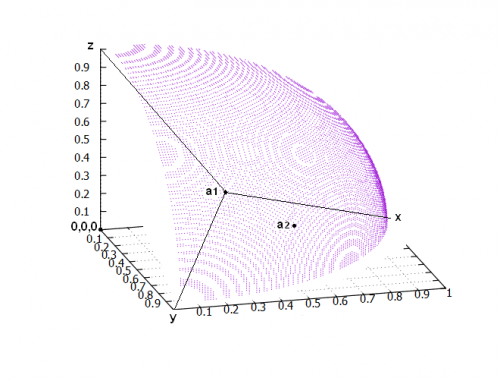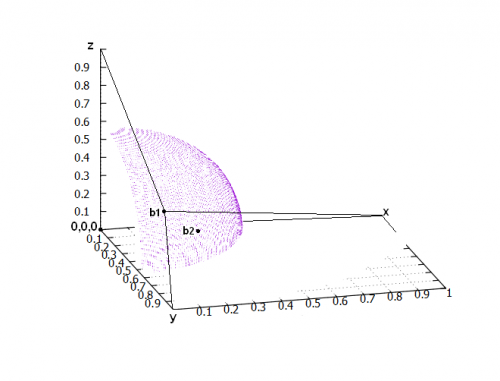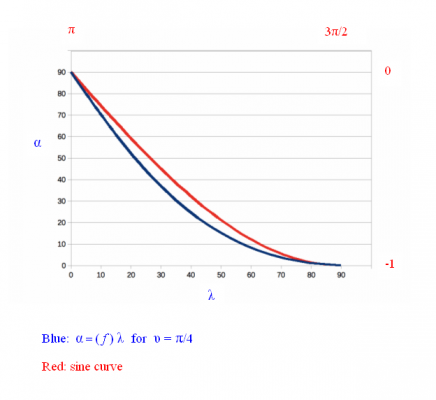-
Posts
296 -
Joined
-
Last visited
Content Type
Profiles
Forums
Events
Everything posted by steveupson
-

Thoughts On Dark Matter
steveupson replied to TheoreticalCheckmate's topic in Modern and Theoretical Physics
Is it possible to be more vague with this moderation note? I assume it is in response to my post. I just used the google to search for "dark+matter -energy" and it was all simply stuff about tv and movies. My understanding is that all descriptions/theories wrt dark matter include dark energy. Am I missing something? Is dark matter really something that that can be discussed separately from dark energy? Is dark energy really considered off topic? This is the second time I feel that I've been accused of wandering of the reservation for no reason at all. Except perhaps to shut me up. The last time was when you tried to make the argument that time going "forwards" was devoid of direction. I'm starting to feel as if you don't like what I have to say, but is it really that important to you to keep me from expressing my understanding? Direction is a base quantity whether people like the idea or not. The math is the math and the math doesn't lie. -

Thoughts On Dark Matter
steveupson replied to TheoreticalCheckmate's topic in Modern and Theoretical Physics
The basic equation is here: http://www.scienceforums.net/topic/101726-formalizing-length-as-an-antivector-algebra-help-requested-once-again/?p=963786 I think that I can explain how the math works, and how our understanding of direction accounts for dark energy. -
The function [latex]\alpha=f(\lambda)[/latex] turns out to be: [latex]\alpha={\cot}^{-1 }(\cos\upsilon\tan{\sin}^{-1}(\frac{\sin\frac{\lambda}{ 2}}{ \sin\upsilon}))[/latex] It is a smooth function that approaches a sine curve when [latex]\upsilon\to0[/latex], and that approaches a hyperbola when [latex]\upsilon\to\frac{\pi}{2}[/latex].
-
Here are some basics for you, and maybe you can refine the question a little to get a better response if this isn't what you need. The size of the combustion chamber for a given engine can be calculated if you know the displacement, number of cylinders, and the compression ratio. The combustion chamber size is a measure of its volume. The compression ratio of an engine is the volume of the cylinder when the piston is at bottom dead center (maximum volume of the cylinder) relative to the volume of the cylinder with the piston at top dead center. The volume at top dead center is the minimum volume of the cylinder, and is also the volume of the combustion chamber. In other words, the size of the combustion chamber is the volume of the cylinder when the gas charge is fully compressed at the top of the stroke. We have a four-cylinder two-liter engine. Each cylinder displaces 500cc during a stroke. If the compression ratio is 10:1 then you know that the combustion chamber is 50cc. Typically, engines in street cars have compression ratios ranging from about 8:1 to 10:1 although there are still many that fall outside this range. A typical diesel might be 14:1 to 18:1 because it needs a lot more compression which will raise the temperature of the fuel/air charge to the point where it ignites.
-
If we were to shine a light across the universe how fast could we make the shadow move at the other side? There must be a theoretical limit, right?
-
Nor are shadows. The analogy seems perfect. I was considering the shadow to be the image on the surface. But I see now that there can be two meanings. On edit>>> You're right though, after more thought there must be a limit that is not instantaneous. Would this limit be the Planck time?
-
(cough)socialist(cough)
-
Something very basic and very fundamental is being overlooked here. When we do the thought experiment where the shadow puppet is passed in front of a spotlight that is aimed at the moon it is important to look at the question in terms of “now” vs. past and future. At the instant the photon is emitted, it has a future that lies in the direction of the moon. When the puppet is placed between the two its future changes. How fast does that change occur? That would be the “speed of shadows” to my way of thinking. These changes of futures can only happen in the “now” which is what makes it so special. I don't see this as a philosophical argument, and I would say that the speed of shadows is instantaneous.
-
I imagine that there's a closet with 20,000 pairs of shoes in our future.
-
Of course you’re right. It’s not only unfair what I said, it’s also unreasonable for me to expect that everyone will automatically understand what I’m thinking. I’m not really frustrated with the help I’m getting, it’s my inability to communicate that’s making me nuts. My feelings of inadequacy are helped by knowing that you don’t know how to do this either. Thank you for your honesty about this. I know people only want to help. The function is supposed to map [math]\alpha[/math] as a function of [math]\lambda[/math]. The angle [math]\upsilon[/math] is the angle of interest, and it will be an acute angle. For each value of [math]\upsilon[/math] there will be a different map, which I think means that there will be a different function for each of these values. This is because a function maps a set of inputs to outputs, and the set of outputs will vary depending on the value of [math]\upsilon[/math]. It’s been explained to me that since [math]\alpha[/math] has been expressed as a function of [math]\phi[/math], and [math]\lambda[/math] has been expressed as a function of [math]\phi[/math], that this is a parameterization of [math]\alpha = f(\lambda)[/math]. I know (I think) that in order to get the equations into the form that I’m after it will be necessary to cancel out [math]\phi[/math] in order to make one relationship. Also, I think what we're trying to do is to hold [math]\upsilon[/math] constant for each instance of [math]\alpha = f(\lambda)[/math]. I don't know how to write this algebraically. Please understand that I'm not trying to change any existing methods for expressing mathematical representations of physical phenomena. This adventure would be in addition to existing methods which are not lacking in any way, except perhaps around the fringes when we approach the chasm. I had a new idea of how to try and explain the overall strategy. The previous draft paper was an explanation of how [math]\alpha = f(\lambda)[/math] is derived. The following explanation is supposed to explain how the function is to be utilized. In order to try this approach, I’ve modified some artwork that’s been taken from another publication that I wish to credit: https://www.researchgate.net/publication/282979400_Computing_Nash_Equilibria_and_Evolutionarily_Stable_States_of_Evolutionary_Games Each of the two figures have points [math]xyz[/math]. We also have two points [math]a_1[/math] and [math]a_2[/math] shown on a spherical surface. There is an angle a_1(0,0,0)z [math]a_1z(0,0,0)[/math] that we’ll call the output of the function for [math]\upsilon_{a_1z}[/math]. There is an angle a_1(0,0,0)y [math]a_1y(0,0,0)[/math] that we’ll call the output of the function for [math]\upsilon_{a_1y}[/math], and there is an angle a_1(0,0,0)x [math]a_1x(0,0,0)[/math] we’ll call [math]\upsilon_{a_1x}[/math]. <on edit: xyz are the vertices> These three angles are each expressed as a separate 2D value based on the function that we’re trying to compose. We also have three more angles that relate to point [math]a_2[/math] on the surface of the sphere which are [math]\upsilon_{a_2x}[/math], [math]\upsilon_{a_2y}[/math], and [math]\upsilon_{a_2z}[/math]. Each of these is also expressed as a 2D value. The theory is that, when done properly, [math]\upsilon_{a_1x}+\upsilon_{a_1y}+\upsilon_{a_1z}=\upsilon_{a_2x}+\upsilon_{a_2y}+\upsilon_{a_2z}[/math]. All the points on the surface yield the same sum. The entire explanation can be repeated for points [math]b_1[/math] and [math]b_2[/math] in the second illustration. All the points on that surface will yield the same sum, which will be different than the one in the first example. In both cases, the magnitude of the sum is the "reverse vector" or "antivector" of the length represented by the radius of the surface. It’s exactly a mirror image (mathematically) of the normal vector. The length doesn’t have any specified direction and it’s completely specified by the three direction coordinates, or angles. Or, I'm imagining things, in which case our work will be wasted but you'll still have my undying appreciation.
-
I'd love to work through a few examples. That's the whole reason for this discussion. And, I sort of understand everyone's unwillingness to help me. Is there some reason why these two equations can't be expressed as a function? Do you know the answer to that question? I can understand that you wish to know why I would ask this question, and I've done my darnedest to explain. If you can't help then that's fine. There's no reason to challenge me in order to get me to explain. I've been trying to explain. Like much of physics, it's not really possible to explain certain things without using math. One problem is that I don't look at things the same way as I used to, so it's difficult to recall the way I used to see things. An example: It's impossible for me to understand polarization without geometry. For me, it's based on geometry. Direction is not what I used to think it was.
-
Im trying to toss a small pebble across the chasm of ignorance. The chasm is documented extremely well in this video: www.youtube.com/watch?v=ZihywtixUYo A lot of movers and shakers in the scientific community are convinced that the next big breakthrough will be in mathematics. Physics relies on a very specific geometry for almost all of the mathematics. What if there were another geometry that was possible, one in which the mathematical roles of length and direction are reversed? What would a transverse Doppler effect of a transverse wave look like if it were modeled in a geometry based on direction instead of length? What would quantum entanglement look like if it were modeled in a geometry based on direction instead of length? This is the elevator pitch, I guess, but I have been discouraged many times from using it, though, because next Ill be pitching the method for extracting free energy from the N-layer using Teslas secret method. The online math experts all claim that this is simply trivial math, simple rotations and stuff that is learned in a first-year course. Only none of them have been able to express the function. Why is that? Its been months (years) now. I know that a function should be able to be composed from these two parallel equations. I know that there should be two arguments, [math]\upsilon[/math] and [math]\lambda[/math], and that someone should be able to express [math]\alpha[/math] as a function of [math]\lambda[/math] while [math]\upsilon[/math] is held constant. If this isnt possible to do, then does anyone have any clue as to why not?
-
You lose the formatting when you go to a .txt file and the resulting file is gibberish. I agree with the OP that this is a problem. I would recommend printing the Word file to a .pdf and then try and upload the image. If it isn't really yuge this should work.
-

Questions about Time
steveupson replied to AbstractDreamer's topic in Modern and Theoretical Physics
Not necessarily. Position can be defined as a distance and direction measured from a reference. In order to have a change of position then one or the other of these two things must change. Time must elapse in order to have a change in distance of any particle (or point) from the reference. It is possible for this change in distance to cause no change in direction from the reference. Let's break this down so that we are looking only at distance or direction independently. We know that no two points can change distance from one another at a rate that is faster than c. But how about direction? Is the change in direction limited by c? Nothing that I know of in physics would prevent the change in direction between any two points from occurring simultaneously synchronously. There is math (that no one seems to understand because I am so limited in my ability to explain it) that shows that directions are all connected to one another through an equation (similar to the way distances are relative to one another using Pythagoras or pi.) Since these equations that relate directions to one another are invariant under relativistic transformations, then one might reasonably assume that direction isn't something that is hampered by the universal speed limit. -
I'm not sure that these answers will make any sense if the math behind the function isn't clear. There is no specification of any length, other than what would be necessary to define where the surface of a sphere is positioned in space. This particular attribute (psuedo-length?) has no defined direction. It's a sphere located in space. The dimension (pseudo-length) is defined solely by the three direction coordinates, which don't relate to any particular length. This scheme is separate (completely separate) from the standard system. There's no trivial method that I know of that would allow the ability to move back and forth between this system and the normal system. As for the orthogonal question, orthogonality is an axiom, but I don't think that's what your question is asking. I can't seem to put the question in any context for which I have an answer.
-
I'm not explaining this very well. There isn't really a unit cone. There really isn't a unit anything because there are no lengths, but If you have to think of it as having a unit anything, it would have to be the sphere that is defined by the way the three cones intersect one another. The unit is a unit of direction in this scheme, not a unit of length. It becomes a length because of how these three individual directions are combined mathematically, and this length is expressed as three separate directions, analogous to the way a normal vector expresses direction as three separate lengths. Again, we must start at the beginning because the math is important to understand. The two equations must be used in order to assign a value to each cone, and this value is not anything that has something analogous to it that I've been able to find in any of my research. The function expressed in the equations behaves differently than other functions so it is critical that the function be understood, or at least rewritten to show [latex]\alpha[/latex] and [latex]\lambda[/latex] are going to produce a different curve for each value of [latex]\upsilon[/latex]: [latex]\cot\alpha = \cos\upsilon\tan\frac{\phi}{2 }[/latex] [latex]\sin\frac{\lambda}{2 } = \sin\frac{\phi}{2 }\sin{\upsilon}[/latex] When [latex]\upsilon[/latex] is near zero the function approaches a sine curve and the area beneath the curve will be 0.707 and when [latex]\upsilon[/latex] is near [latex]\frac{\pi}{4}[/latex] the function approaches a step function and the area beneath the curve approaches 0.0 (or 1, because the function wraps around somehow, depending on which side of the step function you look at.) Each cone will have a value between 0 to 1 assigned to it, depending on the aperture, and this number is determined using the function. I suppose that the cone with an assignment of 1 could be referred to as a unit cone but this would be very misleading since the 1 simply specifies that the aperture is [latex]\frac{\pi}{2}[/latex] and doesn't really specify any unit length. So, each of the three cones has point D on the surface and is represented by a value between 0 and 1. This value is the area under the curve produced by the function. The radius of the sphere is defined by the direction that results when the three values are combined.
-
The direction coordinates are different than what you think they are. They are each the area under a curve which is found by using the function described above. Each of these coordinates is simply a number with a range of 0 to 1 (I think that's the range, but I need some help to make sure about it) that represents the 3D space enclosed by a cone which has point D on its surface. When we combine these three numbers we get a result that is proportional to the distance between D and the origin, or in other words a radius of sphere of a certain size. What makes this representation different is that length is expressed as a formula or an equation that doesn't use length as a parameter. As for its usefulness, there's probably something wrong with the math that makes it impossible for it to work properly. It's very likely that I have developed a bias about how this all works and that this bias is leading me to some wrong conclusions. My result are very inconsistent trying to do this on my own and I tend to accept expected results, no matter how sloppily obtained, while also thinking I must have made mistakes when there are unexpected results, no matter how careful I've been. Help is needed with the algebra in order to be able to work a few examples in a convincing manner. Do you think you'd be able to help compose a function? Even some help running more graphs with different angles would be appreciated.
-
The natural reaction is to try and specify a length somewhere in order to make this comprehensible with regards to other stuff that we already know about. I need to explain the concept of an antivector a little more. With a standard direction vector in 3D, the length is a constant and the coordinates combine mathematically in order to specify the direction that lies along a subtended line though a specified point that is a distance of one from the origin. The direction doesn't have a magnitude or value that is independent of the ratio of lengths of the straight line distances specified by the values of the xyz coordinates. With the antivector in 3D the opposite occurs. The direction coordinates, when taken together, sum to a particular magnitude and this magnitude represents a particular length or distance that the specified point is displaced from the origin. In other words, the magnitude of the three direction coordinates, once mathematically combined, will specify a sphere. The radius of the sphere doesn't have a magnitude or value (length) that is independent of the quantity of the direction values of the xyz coordinates.
-
The figure should have been fixed several iterations ago. Sorry about that. The axis and the curves were both wrong. As far as how it works, I can't really explain it without using the math, which is probably a lot murkier than what I think it is. It must be impenetrable or else this would have all been done before. There is a relationship between angles that occurs in 3D that does not occur in 2D. There is at least one of these relationships, and I would guess that there are more, probably. The best that I can do to explain it is to solve a spherical right triangle and show these two simultaneous equations: [latex]\cot\alpha = \cos\upsilon\tan\frac{\phi}{2 }[/latex] [latex]\sin\frac{\lambda}{2 } = \sin\frac{\phi}{2 }\sin{\upsilon}[/latex] I know that it must be possible to compose a function for [latex]\upsilon[/latex] from these equations that will define a curve similar to the one shown in Fig 5. .
-
Help is needed, once more, in expressing these equations using proper algebra and proper nomenclature. The math seems to work ok, it just needs to be corrected for grammar and puctuation, so to speak. To try and avoid some confusion as to exactly what this topic is about, some new terminology is introduced in order to distinguish this technique from other, more standard, methods. The main addition is the term antivector. This is no different (mathematically) than a standard vector where the roles of length and direction have been reversed. Basically, this new terminology has been invented in order to help assure other members that this author understands what a standard vector is, how it works, and more importantly, why it works the way it does, which seems to be a somewhat controversial subject. I'd like to avoid any controversy as much as possible, and I'm open to any reasonable suggestions on how the terminology should be approached if this nomenclature is unacceptable. In order to create a system that uses antivectors, it is first necessary to quantify direction in a manner that is more similar to the way that length is currently quantified for use in standard vectors. The ability to define this quantification mathematically allows direction to be expressed as a scalar value which becomes the magnitude of the antivector, with length becoming the antivector quantity. The method used for quantifying direction is shown in the attached file below. The method returns a [latex]2D[/latex] graph. The area [latex]A[/latex] below the curve in the graph is the scalar value of angle [latex]\upsilon[/latex]. To create the antivector we will use this value (area [latex]A[/latex]) to locate a point [latex]D[/latex] in space such that the distance [latex]d[/latex] from the origin will be expressed as magnitude of direction. Begin this part with a blank sheet, which is not to be confused with the other coordinates used in the preliminary draft paper referenced above. First, name a non-zero point [latex]P_x[/latex] somewhere along the positive [latex]x[/latex] axis. Construct a cone with the apex at [latex]P_x[/latex] and the base at the [latex]yz[/latex] plane. The axis of this cone is coincident with the [latex]x[/latex] axis and the aperture will be 90º. (More specifically, the aperture of the cone does not have to be specified in degrees or radians, but instead the entire surface is parameterized by the area [latex]A[/latex] beneath the curve for the function of angle [latex]\upsilon[/latex], where [latex]\upsilon[/latex] is 45º. In other words, if I’m saying this correctly, [latex]A=(f)\upsilon[/latex] where both [latex]A[/latex] and [latex]\upsilon[/latex] have unique geometric interpretations.) Next, where the cone intersects the positive [latex]y[/latex] axis and positive [latex]z[/latex] axis (call these points [latex]P_y[/latex] and [latex]P_z[/latex] ), construct two more congruent cones with bases in the [latex]xy[/latex] and [latex]xz[/latex] planes. Make point [latex]D[/latex] a point somewhere within the volume of space occupied by the three cones. Make the [latex]x[/latex] coordinate of [latex]D[/latex] ([latex]x[/latex] coordinate of the antivector) equal to [latex]A_x[/latex] where [latex]A_x=(f)\upsilon_x[/latex] and [latex]\upsilon_x[/latex] is the angle between the [latex]x[/latex] axis and point [latex]D[/latex] with vertex at [latex]P_x[/latex]. The [latex]y[/latex] and [latex]z[/latex] antivector coordinates are expressed similarly. We should have three areas, [latex]A_x, A_y,[/latex] and[latex] A_z[/latex], which are the direction coordinates of point [latex]D[/latex] in the antivector space. We should also have a condition where [latex]\frac{A_x+A_y+A_z}{3}[/latex] is a parameterization of a sphere of radius [latex]d[/latex]. on edit > the draft document has been reloaded with a more current version Abridged Draft (1) (1).pdf
-
Not according to the google.
-
Ok, that's weird and unexpected. I guess it would be too easy if they were simply one way or the other. OTOH, it explains a lot of confusion that I've been having with this subject.
-
The way that I understand it, the two are oriented 90° to one another spatially, but I thought that they were phase shifted 90° to one another temporally. Capitalizing on this spatial orientation is what makes rf directional couplers work. Are the two actually in phase with one another?




